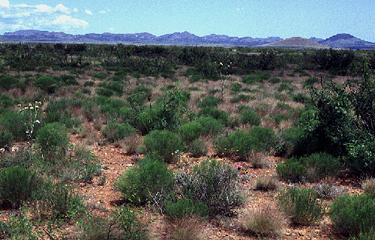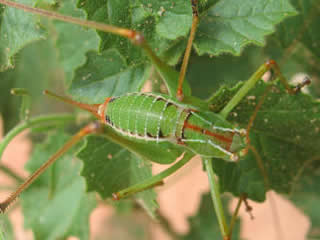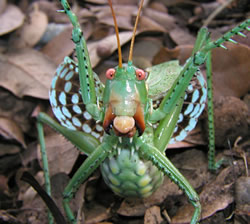
source
Clostridium botulinum, a microbe normally found in soil and water, is an obligate anaerobic bacterium, meaning that oxygen is toxic to its growth. Because of this, it frequently flourishes in foods that have been home-canned. The presence of acid or oxygen will counteract the growth of Clostridium botulinum. The bacteria secrete botulin toxin, which is a neurotoxin whose symptoms include severe muscular paralysis. It is so toxic that 75 nanograms (0.000000075 g) can kill an adult human. However, it also has medical uses: e.g. The primary ingredient of Botox is a diluted form of botulin toxin which reduces skin wrinkles by relaxing facial muscles. Because Clostridium botulinum reproduces by forming spores, it can resist the temperature of boiling water and is very difficult to disinfect.
Although not native to Oklahoma, feral pigs are common in the southeastern part of the state. The thermal neutral zone of the feral pig is 55-85° F. Their diet includes roots, grasses, mushrooms, frogs, snakes and bird eggs. However, some food should be avoided. For example, the ivory funnel mushroom contains the compound muscarine, which acts like the neurotransmitter acetylcholine, and jimson weed contains scopolamine, a chemical that blocks the acetylcholine receptor resulting in deactivation.
There is a high diversity of katydid species in the Chihuahuan desert that is in western Texas, New Mexico, and Mexico. It does not rain very often in the Chihuahuan desert, but when it does during the summer many plants quickly grow leaves and many arthropods (like the katydids) quickly hatch from their eggs.



The main islands of New Zealand were formed while the one large continent of Pangaea still existed. However, with the tectonic shifts, New Zealand separated from what is now known as Australia about 100 million years ago. Until the ancestors of the Maori people first reached the islands of New Zealand by boat, approximately a thousand years ago, the only mammals found on these islands were bats and seagoing mammals. However, there were numerous species of reptiles and birds on these islands. The ancestors of the Maoris brought with them dogs (on purpose) and rats (by accident) when they arrived and these animals quickly increased in numbers.
Jack and Jill went up the hill. At the summit he gave her a red rose. Being overcome by fervent emotions, Jill reminisced over their last year’s trip to the Red Sea. She fondly recalled how Jack had dived and collected algae in deep water (25 meters). He brought the algae to Jill who waited on the shore under a palm tree and she enjoyed their shape and red color. Now, on the top of the hill, glancing at the red rose, Jill was swept by memories and started to talk about the red algae. Stunned by her comments, Jack fell down the hill and injured his back. After Jack fell down, accompanied by Jill, he was rushed in an ambulance to an emergency room run by the Red Cross. A physician examined Jack and told him that his back was sprained and prescribed a powerful muscle relaxer.
To celebrate their adventures on that day, they stopped by Moses’ Red Fish Bistro – an all-you-can-eat restaurant that served an assortment of deep-fried sea food, wrapped in a flat bread – the house specialty. While munching oysters and clams, Jack experienced an urge to flaunt his knowledge about the birds and the bees that pollinate red flowers and flout Jill’s show of knowledge. He explained that a plant can attract a pollinator by producing nectar and the pollinator develops a specialized mouth to collect the nectar. While the pollinator collects nectar it pollinates the flowers.
Jack tried to impress Jill by showing off his knowledge regarding the criteria to define of a species. He told Jill that in North America there are about 7 species of finches called Red Crossbill.
Alas! There was no end to their bad luck on that eventful day. Shortly after Jill had eaten her favorite red crab legs, Jack noticed that she stopped talking, her breath slowed down, her muscles paralyzed and she collapsed. Jill, accompanied by Jack, was rushed in an ambulance to the emergency room run by the Red Cross.
Keas, kakas, and kakapos (honest those are their common names) are flightless species of parrots found on the New Zealand islands as indicated in the figure to the right. The kakas on each of the islands are ecologically distinct and unlikely to breed successfully with those of other islands.

Remember:
Use a #2 pencil to fill in the information on your NCS answer sheet. Put your O-Key Account Username in the boxes indicated for LAST NAME and darken the appropriate circles. Write your Name (Last, First) and “Star”or“NoStar” in the space above the boxes containing your O-Key Account Username. Darken the (S or N) in the last column of the name circles. Enter the number 1132 and darken the corresponding circles in the first 4 columns of the “Student ID.” Failure to perform this correctly will incur a -10pt handling fee. Read all questions and answers carefully before choosing the single BEST response for each question. Feel free to ask the instructor for clarification.